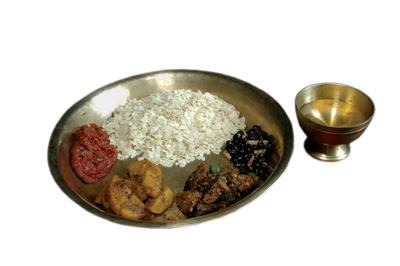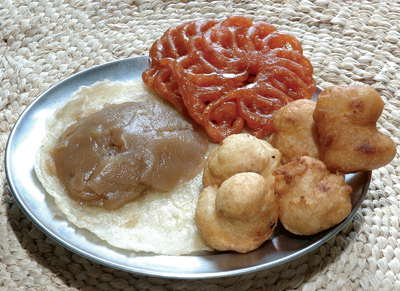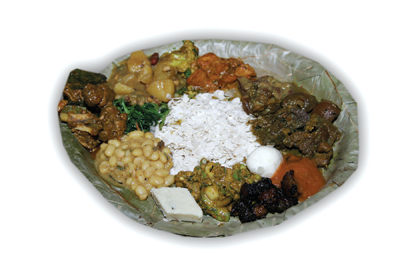Wouldn’t it be nice to hear couples reminding each other of their reservations at the local Newar Restaurant in Barcelona,Tokyo or may be London? Chinese, Thai and Italian foods already have that status. Why not Newar food, with the amazing utensils and the seasonal varieties that celebrate the earth’s rich biodiversity? Over the thousands of years of history of the Kathmandu valley, Newar food and the festivities attached to it have evolved into a unique culture and a wonderful experience. Perhaps it is time to take the Chhoyla (marinated buff meat), ayela (distilled rice brandy), baji (flat rice) and mushya (spiced soya) to the corners of the globe.
 A typical day for the Newar begins with the kaula, which is breakfast made of sweets, puri, halwa, jerri (jilebi), even gwaramari. The main meal in the morning is the jyona and in the late afternoon we have baji with vegetables and meat. Besides the normal day, there are six to ten major feasts (bhoye) that the Newars host – the variety of food items is great and boiled rice is replaced by baji. The Newars take great pride in serving the biggest variety of meat dishes that come from just about every part of the water buffalo. The evening meal is the beli consisting of rice, lentils, a variety of vegetables, pickles and yes, buffalo meat.
A typical day for the Newar begins with the kaula, which is breakfast made of sweets, puri, halwa, jerri (jilebi), even gwaramari. The main meal in the morning is the jyona and in the late afternoon we have baji with vegetables and meat. Besides the normal day, there are six to ten major feasts (bhoye) that the Newars host – the variety of food items is great and boiled rice is replaced by baji. The Newars take great pride in serving the biggest variety of meat dishes that come from just about every part of the water buffalo. The evening meal is the beli consisting of rice, lentils, a variety of vegetables, pickles and yes, buffalo meat.
The natural meal
The dishes that we prepare for each meal or feast follow the natural cycles. Normally while 5-6 dishes make up a meal, feasts (bhoj) consist of at least 16 items, cooked and served in a fixed sequence. Alcohol, yogurt and sweets are served not only in fixed quantities but also keeping in mind the human body and its ability to digest. On the special occasion when new sons-in-law are being welcomed home for the first time, 84 dishes (chaurasi benjan) are prepared.
The medical value of each food item and the methods of cooking are passed on orally from generation to generation. It can get as specific as what should or should not be cooked in which metal pot. Whether it is a common cold or a more serious ailment, grandmothers always seem to know what is appropriate to cook and how to cook it. Newar food is the result of rich biodiversity, but the conservation of this diversity depends on our ability to keep the culinary traditions alive.
 Variety is the spice of life
Variety is the spice of life
Anyone who has walked into a traditional sweet store in the narrow lanes of Kathmandu will know that we have a vast range of foods to suit all palates and the colors to catch the attention of passers by. The colors, shapes and sizes of the sweets speak volumes for their variety. Walk into a pickle store and take in the
innumerable tastes one finds. It is believed that the art of making pickle, dry foods, storing techniques and sun drying for long term preservation are all a result of the fact that Kathmandu has faced drought, war, blockades and a variety of crises that resulted in the need for food security. The Newars have not only internalized, but actually mastered the zero waste principle. The sinki or gundruk (fermented and dried vegetables), radish pickles and flat rice could all have been the result of past food crises.
Global brand: Newar Food
Nepal has contributed several globally recognized brand names such as Everest, Gorkha, Lumbini, Sherpa and Kathmandu. There is no doubt that “Newar Food” can be a global brand if backed up with the wide variety of food and drinks that are universally palatable. Newar food could take its rightful place on the global dining table. What we need at this stage are people who can help train those interested and passionate entrepreneurs how to manage a restaurant; we need architects who can help design the interiors, cooks who can help prepare the recipe. All these need to conform to the food and safety standards of the countries we are taking Newar food to. The number of jobs we shall create will be high. The artisans and farmers of Kathmandu will have plenty of work supplying these restaurants- what a great economic activity we shall have as well.
 Food, Farm and the Farmer
Food, Farm and the Farmer
As we drive or walk past a farm in the Kathmandu valley it becomes obvious that biodiversity is not just a term used by scientists in fancy seminars, but
actually a way of life. You see rice of several varieties. One variety may be for alcohol, another for flat rice, another for worship and yet another to make white beer. In the fields there are patches of garlic, green onions, ginger, turmeric, radishes, spinach and much more. This is definitely not the monoculture that the world has begun to worry about.
Strangely, it is the possibility of spreading this wisdom and the resulting variety of food items globally that will provide the much-needed incentive to conserve the age-old farming practices of the Newar farmer. The menu should read something like “Do not criticize a farmer with your mouth full….”. These people deserve respect and in today’s world of market forces, only the ability to cash this knowledge and practices will get us there. Otherwise we may see all of the land become brick kilns initially, and then eventually, a concrete jungle. The young will go abroad to find odd jobs that are disrespectful and meaningless. What a great incentive the global spread of Newar food could be for preserving our food, the farm and the farmer.
Economic Linkages
Serving Newar food properly requires brass water pots from Palpa and Chainpur, and a silver alcohol decanter (aunti) with small clay cups (salin) for drinking. The table cloth and napkins can be made by the women of the valley who weave in the lean farming seasons as they have done for thousands of years. Copper cooking pots, wooden and ceramic utensils, clay yogurt bowls, all would add value to the local economy. The clothes and jewelry of the waiters and waitresses will put some sparkle in the experience. Throw in some live music from the hundreds of local drums and musical instruments and we have a winner.
Some lesser-known vegetable dishes from the southern plains
I’m not a vegetarian but I love vegetables. And whenever I get to the southern plains of Nepal, I try...









